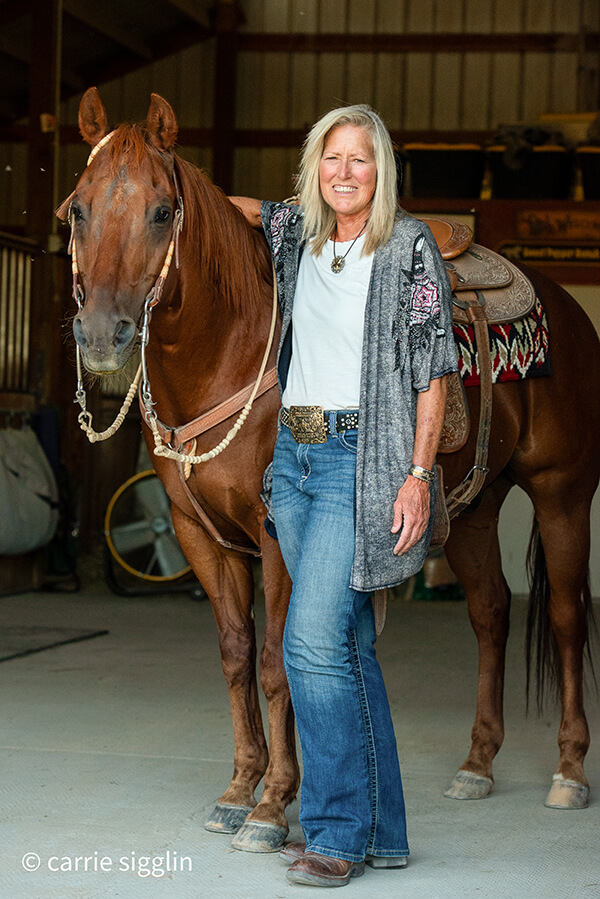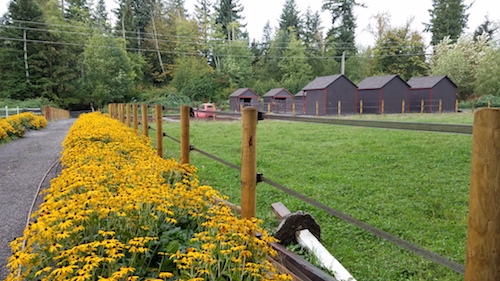Plant Buffers on Horse Properties
by Alayne Blickle

Many horse owners don’t realize how helpful native trees and shrubs can be on a horse property. People, wildlife (including our valuable native pollinating insects), horses, and the environment can all benefit from a landscape of native plants.
Native plants are those that have evolved over thousands of years in their specific regions. These hardy plants have adapted to the geography, hydrology, and climate and have co-evolved with animals, insects, fungi, and microbes. This is important to note as it means we won’t spend money and time helping them along with pesticides or fertilizers which further reduces our environmental impacts.
Native plants are the foundation of our natural ecosystems. As a result, a community of native plants provides habitat for a variety of native wildlife species such as songbirds, pollinating insects, and butterflies.
Even though the Pacific Northwest is quite lush, logging, farming, ranching, and development have caused a tremendous loss of native vegetation and critical wildlife habitat. Enhancing horse properties with native plants wherever possible not only promotes native wildlife, it also helps to control erosion, provides a visual buffer, and helps filter chemicals and nutrients. A tall hedgerow can also act as dust screen and wind barrier. A simple hedgerow of natives may attract beautiful songbirds, butterflies, frogs, and other interesting wildlife for viewing.
Cedars, cottonwood, willows, and dogwoods can sop up a wet area. Violet green swallows can do bug patrol, eating thousands of flies, moths, mosquitoes, and other bugs each day—more than any bug-zapper! Bats will conduct nightly bug raids, racking up thousands more bug deaths. Native roses in a hedgerow along your driveway can welcome visitors with their sweet smell.
We don’t have to look hard to see that exposure to pesticides is being linked to frightening diseases such as nerve damage in adults and cancer in children. Chemicals used outdoors often end up in our surface waters where they can harm fish and other aquatic wildlife, or become a human health issue. The bottom line is simple: any way we can reduce chemical use in our lives and around our horses is a good thing for everyone and everything.
After the first few years of a little extra watering, native plants are ready to go “on their own,” requiring only a minimal amount of care and no special watering. This is an important water conservation technique. Natives cost less to buy than non-native landscaping plants and are equally attractive.
Here are some ways you can use hedgerows and buffers on horse properties:
- Plant a hedgerow of native plants as a visual screen between neighboring uses. Hedgerows can also act as wind barriers for a breezy area or a dust screen around your arena. (Consider: beaked hazelnut, Nootka rose, red flowering currant as well as trees such as Douglas fir, western red cedar, black hawthorn and Pacific crabapple)
- Plant native plants as mud managers alongside confinement areas to reduce flows, absorb water and filter sediments and pollutants. (Consider: red osier dogwood, pacific willow, black twinberry, salmonberry and pacific ninebark)
- Plant native buffers along streams and wetlands to protect riparian habitat by improving water quality and reducing erosion. (Consider: western red cedar, Oregon ash, black twinberry, Pacific ninebark)
- Plant native plants as decorative landscape features near your house and in a hedgerow along the driveway. Choose a variety of evergreen and deciduous plants for year-round coverage. (Consider: red flowering currant, mock orange, salal, sword fern, kinnikinnick)
- Plant native plants instead of lawns to save time and money by reducing or even eliminating the need for fertilizers, pesticides, water and lawn maintenance equipment.(For drier areas consider: Douglas fir, shore pine, Nootka rose, big leaf maple, beaked hazelnut, thimbleberry, snowberry, Oregon grape)
- Plant native plants for wildlife enhancement. The types of plants you choose for food and cover will help determine the wildlife species attracted to your backyard.
Late summer is the right time to begin your plan to “go native.” Your local conservation district, extension office, or native plant society may be able to help with things like selecting native plants for specific issues or problems on your horse property—or with ideas for designing a hedgerow or buffer. Right after Labor Day you’ll be able to begin planting and setting your native plants to work for you!
For concerns about plant toxicity to horses check with your equine veterinarian or contact Horses for Clean Water. Plants listed here are not generally thought of as toxic to horses, but it is recommended none of these plants be used as a diet for horses, nor should horses be allowed to consistently browse them.
Find information on free upcoming Horses for Clean Water events at www.horsesforcleanwater.com
Originally Published August 2017 Issue

Alayne Blickle began in the 1990’s as a pioneer in water conservation and natural resources conservation by creating the entrepreneurial consulting business, Horses for Clean Water, an award-winning internationally acclaimed education program that looks for horse-healthy, nature-based solutions to land management challenges. She continues this work today partnering with agencies, organizations, and horse owners throughout North America and worldwide. She is a regularly contributing writer and photojournalist to several equine publications.
Alayne lives with her horse trainer husband, Matt Livengood, in southwestern Idaho where they raise and train AQHA horses and mustangs on their eco-friendly horse ranch. Contact her through the Horses for Clean Water website or through their ranch website Sweet Pepper Ranch.
For more information contact Alayne at [email protected] or 206-909-0225.






